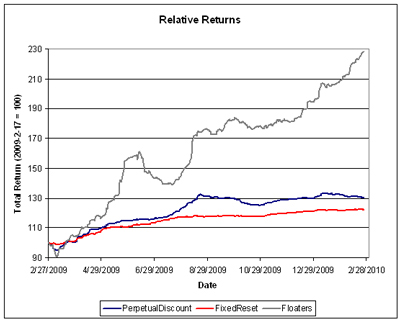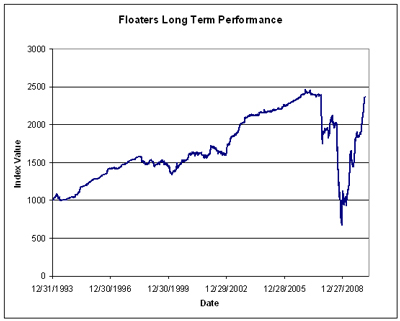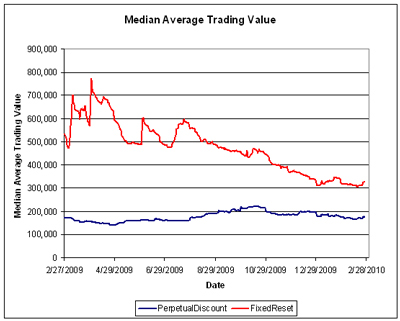Performance of the HIMIPref™ Indices for February, 2010, was:
| Total Return | ||
| Index | Performance February 2010 |
Three Months to February 26, 2010 |
| Ratchet | +14.57%* | +31.74%* |
| FixFloat | +6.16% | +15.89% |
| Floater | +9.18% | +25.54% |
| OpRet | -0.45% | -0.02% |
| SplitShare | +0.72% | +0.90% |
| Interest | -0.45%**** | -0.02%**** |
| PerpetualPremium | +0.44% | +-0.02% |
| PerpetualDiscount | -1.35% | +0.84% |
| FixedReset | +0.31% | +0.96% |
| * The last member of the RatchetRate index was transferred to Scraps at the February, 2009, rebalancing; subsequent performance figures are set equal to the Floater index
Independent measurement was resumed when an issue qualified for inclusion (transferred from Scraps) at the February, 2010, rebalancing. |
||
| **** The last member of the InterestBearing index was transferred to Scraps at the June, 2009, rebalancing; subsequent performance figures are set equal to the OperatingRetractible index | ||
| Passive Funds (see below for calculations) | ||
| CPD | +0.18% | +1.90% |
| DPS.UN | -1.61% | +1.53% |
| Index | ||
| BMO-CM 50 | +0.38% | +2.99% |
| TXPR Total Return | +0.20% | +1.94% |
The pre-tax interest equivalent spread of PerpetualDiscounts over Long Corporates (which I also refer to as the Seniority Spread) ended the month at +235bp, unchanged from January month-end. The decline in the PerpetualDiscount index was due to an increase in yields on long corporates from 5.8% to 5.9%, with the Seniority Spread remaining constant.
The relative returns on Floaters over the past year continues to impress:
But one must remember how they got there:
FixedReset volume seems to have found a level. Volume may be under-reported due to the influence of Alternative Trading Systems (as discussed in the November PrefLetter), but I am biding my time before incorporating ATS volumes into the calculations, to see if the effect is transient or not. The average volume of FixedResets continues to decline, which may be due to a number of factors:
- The calculation is an exponential moving average with dampening applied to spikes. While this procedure has worked very well in the past (it is used to estimate the maximum size of potential trades when performing simulations) there are no guarantees that it works well this particular time
- Other than a burst of issuance in January, there hasn’t been much issuance of investment-grade FixedResets recently, which will decrease the liquidity of the whole group, both for technical and real reasons
- The issues are becoming seasoned, as the shares gradually find their way into the accounts of buy-and-hold investors
As discussed in January, the impressive returns of the past year cannot continue indefinately. The long term return on a fixed income instrument is its yield – 5.9% for a PerpetualDiscount, and about 3.6% to the call date for a FixedReset.
Compositions of the passive funds were discussed in the September edition of PrefLetter.
Claymore has published NAV and distribution data (problems with the page in IE8 can be kludged by using compatibility view) for its exchange traded fund (CPD) and I have derived the following table:
| CPD Return, 1- & 3-month, to February 26, 2010 | ||||
| Date | NAV | Distribution | Return for Sub-Period | Monthly Return |
| November 30, 2009 | 16.77 | |||
| December 24 | 16.76 | 0.21 | +1.19% | +1.98% |
| December 31, 2009 | 16.89 | 0.00 | +0.78% | |
| January 29 | 16.80 | -0.53% | ||
| February 26, 2010 | 16.83 | +0.18% | ||
| Quarterly Return | +1.90% | |||
Claymore currently holds $420,750,223 $397,666,518 (advisor & common combined) in CPD assets, up about $23-million from the $397,666,518 reported last month and up about $47-million from the $373,729,364 reported at year-end.
The DPS.UN NAV for February 24 has been published so we may calculate the approximate February returns.
| DPS.UN NAV Return, February-ish 2010 | ||||
| Date | NAV | Distribution | Return for sub-period | Return for period |
| January 27, 2010 | 20.26 | |||
| February 24, 2010 | 19.91 | -1.73% | ||
| Estimated January Ending Stub | -0.00% ** | |||
| Estimated February Ending Stub | +0.12% * | |||
| Estimated February Return | -1.61% *** | |||
| *CPD had a NAVPU of 16.81 on February 24 and 16.83 on February 26, hence the total return for the period for CPD was +0.12%. The return for DPS.UN in this period is presumed to be equal. | ||||
| **CPD had a NAVPU of 16.80 on January 27 and 16.80 on January 29, hence the total return for the period for CPD was 0.00%. The return for DPS.UN in this period is presumed to be equal. | ||||
| *** The estimated February return for DPS.UN’s NAV is therefore the product of three period returns, -1.73%, 0.00% and +0.12% to arrive at an estimate for the calendar month of -1.61% | ||||
Now, to see the DPS.UN quarterly NAV approximate return, we refer to the calculations for December and January:
| DPS.UN NAV Returns, three-month-ish to end-February-ish, 2010 | |
| December-ish | +1.78% |
| January-ish | +1.39% |
| February-ish | -1.61% |
| Three-months-ish | +1.53% |



[…] Volume was good today but price action was muted, with PerpetualDiscounts gaining 2bp and FixedResets up 3bp. There were only two entries on the performance highlights tables – from the Floating Rate class, naturally enough! […]
[…] discussed in February, the impressive returns of the past year cannot continue indefinately. The long term return on a […]
[…] to see the DPS.UN quarterly NAV approximate return, we refer to the calculations for February and […]